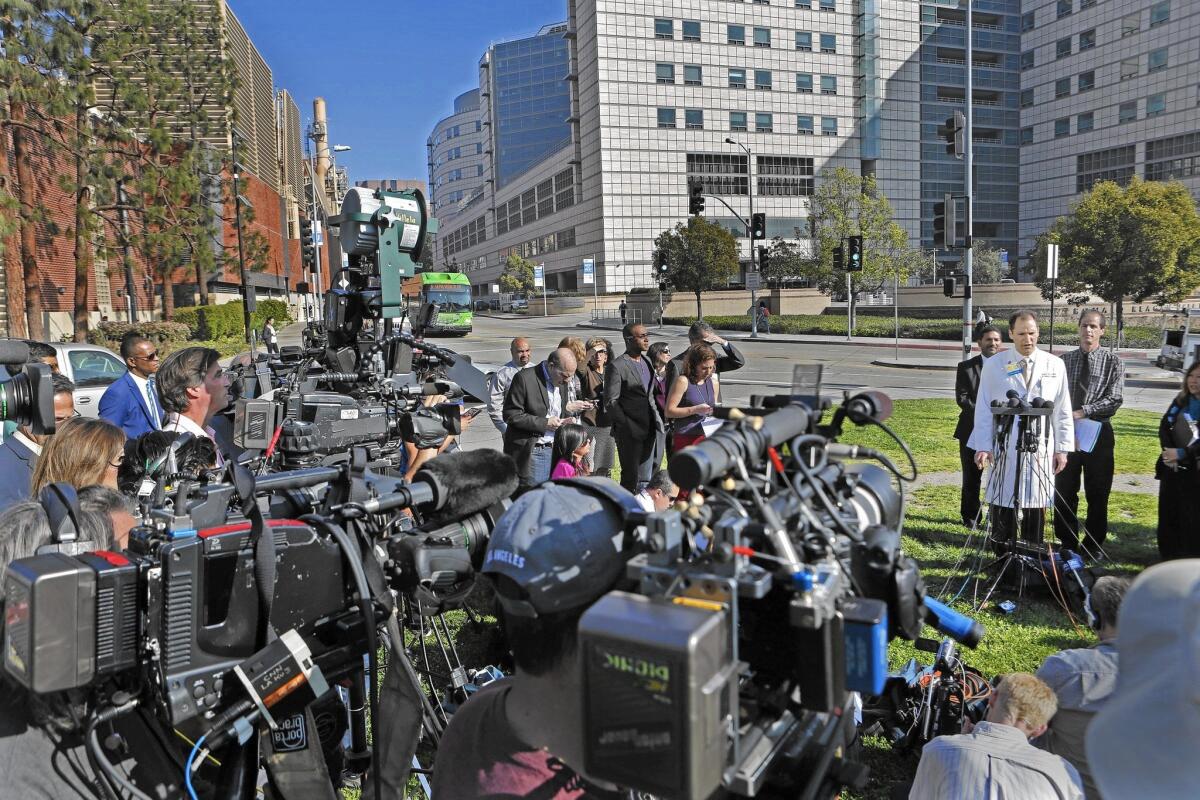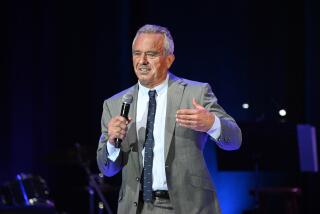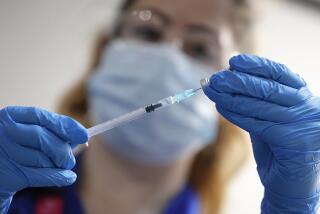Statistic on safety of medical scopes ‘inaccurate, outdated,’ researchers say

Dr. Zachary Rubin, associate clinical professor of infectious diseases and medical director of clinical epidemiology and infection prevention, center, speaks about the recent outbreaks linked to tainted medical scopes at the Ronald Reagan UCLA Medical Center.
- Share via
For decades, doctors reassured patients about the safety of medical scopes with a single statistic.
The number has been cited in brochures, handed out in clinics and included in guidelines written by medical societies. It has been repeated so many times that some attribute it to a study by the federal government.
The estimate — that the risk of getting a serious infection from an endoscope is just 1 in 1.8 million procedures — brought relief. It implied that the danger was virtually nonexistent.
But the statistic is 22 years old. And even then it was wrong.
The calculation is “inaccurate, outdated, based on flawed methodology, and can have profound effects on patients,” a group of researchers wrote in the American Journal of Infection Control after looking into its origin.
The risk estimate was determined in 1993 by a committee at the American Society for Gastrointestinal Endoscopy, the largest group of American doctors specializing in endoscopic procedures.
The society cites the statistic in a brochure titled “Ensuring the Safety of Your Endoscopic Procedure,” which it has distributed to clinics and hospitals across the country.
“Given the multiple benefits of endoscopy,” the patient brochure states, “it is no wonder that the number of procedures performed grows each year.”
Doctors at the Centers for Disease Control and other experts say they don’t know the true risk of infection because so few of the cases are publicly reported.
Part of the problem is that patients may not get sick for many days or months after the procedure, making it hard to link the two.
Hospitals and doctors also have little incentive to report the infections because of the potential for lawsuits or financial penalties from regulators.
The researchers who traced the statistic’s history found errors in the 1993 committee’s mathematical calculations.
They also found that the endoscopy society’s committee had greatly underestimated the risk by counting only the number of scope-caused infections written about in medical journals. The researchers pointed out that the cases are rarely reported in the scientific literature, making the committee’s calculations “not methodologically sound.”
After The Times asked about the statistic in June, Gina Steiner, a spokeswoman for the endoscopy society, said the doctors’ group would delete the risk estimate from its website and plans to remove it from new patient brochures.
“We do not disagree with the limitations of prior estimates,” Steiner said, “and have in fact advocated for better prospective data.”
She didn’t explain why the doctors group had not updated the statistic in 22 years.
Because of recent outbreaks linked to tainted scopes, including one at UCLA where three people died, the endoscopy society is now updating its guidelines for disinfecting the devices, Steiner said.
“Nothing is more important than patient safety,” Dr. Douglas Faigel, the society’s president, said in a statement. “It’s in all of our best interest to prevent the transmission of infection.”
The group who looked into the risk estimate in the 2013 report included Cori Ofstead, an epidemiologist and consultant who works on infection control issues for medical providers and manufacturers, as well as Pritish Tosh, a physician at the Mayo Clinic.
They wrote that they began doubting the statistic’s accuracy after reading audits that revealed widespread problems in disinfecting endoscopes at hospitals and clinics across the country.
Some of those cases have potentially exposed thousands of patients to dirty endoscopes because the problems were not discovered for many months. For example, the Department of Veterans Affairs notified more than 10,000 patients in 2009 that they may have been exposed to blood-borne pathogens because scopes weren’t properly disinfected.
Ofstead’s group said the infections were “potentially quite common” depending on how well the scopes were cleaned.
Faigel disagreed with that statement, saying it was “nothing more than speculation.” He said the risk of infection was “very low” but didn’t provide support for how the endoscopy society had determined that.
In March, after news of the UCLA outbreak, the Joint Commission, a powerful national group that accredits hospitals, warned about infections from contaminated scopes.
The commission said it was continuing to find “serious noncompliance issues” in cleaning scopes at the hospitals, outpatient surgery centers and clinics across the country.
The Joint Commission added that although the estimate of 1 infection in every 1.8 million procedures had been cited for years, “the true incidence of infections related to endoscopic procedures remains unknown.”
Twitter: @melodypetersen
MORE COVERAGE ON OUTBREAKS:
Serious infections tied to medical scopes go far beyond issues with a single device
A veil of secrecy shields hospitals where outbreaks occur
More to Read
Inside the business of entertainment
The Wide Shot brings you news, analysis and insights on everything from streaming wars to production — and what it all means for the future.
You may occasionally receive promotional content from the Los Angeles Times.











